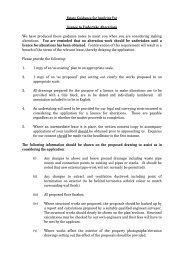The best of Chelsea by the people who know - Cadogan
The best of Chelsea by the people who know - Cadogan
The best of Chelsea by the people who know - Cadogan
You also want an ePaper? Increase the reach of your titles
YUMPU automatically turns print PDFs into web optimized ePapers that Google loves.
6 | HISTORY | A short history <strong>of</strong> <strong>Chelsea</strong><br />
Royal Borough <strong>of</strong> Kensingon & <strong>Chelsea</strong>, Family & Children’s Service<br />
<strong>the</strong> lives <strong>of</strong> <strong>the</strong> residents in that period.<br />
<strong>The</strong> first mention <strong>of</strong> <strong>Chelsea</strong> – ‘cealchy<strong>the</strong>’<br />
– appears in <strong>the</strong> Anglo-Saxon<br />
Chronicle’s AD 785 record as <strong>the</strong> place<br />
where a ‘litigious synod was holden’. <strong>The</strong><br />
Old English word ‘cealc’ can mean<br />
chalk, stone or lime, and ‘hy<strong>the</strong>’ translates<br />
as ‘landing place’. It is possible that<br />
<strong>Chelsea</strong> was a stopping point for boats<br />
shipping building materials or lime for<br />
fertiliser.<br />
Whatever its original purpose, <strong>Chelsea</strong><br />
became a place <strong>of</strong> religious and political<br />
significance. Between AD 785 and<br />
AD 816, at least ten religious synods<br />
were held in <strong>the</strong> area. It is thought that<br />
<strong>the</strong> Mercian kings, <strong>who</strong> largely ruled what<br />
is now <strong>the</strong> Midlands, kept a residence<br />
at <strong>Chelsea</strong> to in order to deal with <strong>the</strong><br />
Church and London. <strong>The</strong> etymology <strong>of</strong><br />
<strong>the</strong> near<strong>by</strong> hamlet <strong>of</strong> Kensal – derived<br />
from cyning holt meaning ‘king’s wood’<br />
– also suggests <strong>the</strong>re was a strong<br />
royal link.<br />
<strong>The</strong> political importance <strong>of</strong> <strong>Chelsea</strong><br />
was still in evidence at <strong>the</strong> end <strong>of</strong> <strong>the</strong><br />
<strong>The</strong> synod <strong>of</strong> AD785 as played<br />
out at <strong>the</strong> <strong>Chelsea</strong> Pageant<br />
in 1908<br />
ninth century. Viking attacks had plagued<br />
London and <strong>the</strong> surrounding area from<br />
AD 830 onwards. According to <strong>the</strong><br />
Anglo-Saxon Chronicle, <strong>the</strong>re was “great<br />
slaughter” in London in AD 839 – 850<br />
Viking ships entered <strong>the</strong> mouth <strong>of</strong> <strong>the</strong><br />
Thames in AD 851 and stormed London<br />
and Canterbury, and in AD 871 a “large<br />
hea<strong>the</strong>n army”, which had been in<br />
England since AD 866, captured London<br />
and wintered <strong>the</strong>re.<br />
By AD 898, King Alfred <strong>the</strong> Great had<br />
suppressed <strong>the</strong> threat from Denmark with<br />
a series <strong>of</strong> victories, concluding <strong>the</strong><br />
‘Danish War’. He <strong>the</strong>n met with religious<br />
and political leaders at <strong>Chelsea</strong> to discuss<br />
<strong>the</strong> refounding <strong>of</strong> London.<br />
Norman conquest<br />
In AD 1086, 20 years after <strong>the</strong> Norman<br />
conquest which brought Anglo-Saxon<br />
dominance in England to an end, <strong>the</strong><br />
Domesday Book recorded that <strong>the</strong><br />
Manor <strong>of</strong> <strong>Chelsea</strong> – covering 780 acres <strong>of</strong><br />
meadow, pastureland and woodland, and<br />
with 60 pigs – was valued at nine pounds.<br />
In <strong>the</strong> centuries after <strong>the</strong> Norman<br />
conquest, <strong>Chelsea</strong> remained largely<br />
unchanged. <strong>The</strong> Anglo-Saxon settlement<br />
<strong>by</strong> <strong>the</strong> river continued to be <strong>the</strong> focus <strong>of</strong><br />
<strong>the</strong> area, and was surrounded <strong>by</strong> fields <strong>of</strong><br />
arable land. <strong>The</strong> Thames retained its<br />
importance to <strong>the</strong> village. Travelling <strong>by</strong><br />
river was faster and safer than <strong>by</strong> land,<br />
and <strong>Chelsea</strong>’s position on its banks, two<br />
and a half miles upriver from Westminster,<br />
meant that a boat owner could travel<br />
<strong>the</strong>re quickly. This convenience became a<br />
draw for <strong>the</strong> rich and powerful, and from<br />
<strong>the</strong> 13th century onwards, court <strong>of</strong>ficials,<br />
nobles and kings are said to have used<br />
<strong>the</strong> area.<br />
<strong>The</strong> Black Death<br />
Even though <strong>the</strong> Manor <strong>of</strong> <strong>Chelsea</strong><br />
was quite secluded during this period,<br />
its proximity to London meant that it was<br />
vulnerable to <strong>the</strong> plague. In <strong>the</strong> mid-14th<br />
Henry VIII and<br />
Sir Thomas More<br />
By <strong>the</strong> time Pepys was setting <strong>of</strong>f on his<br />
unfortunate journey, <strong>Chelsea</strong> had already<br />
undergone major transformation.<br />
In <strong>the</strong> 16th century, great mansions began<br />
to appear and a significant royal endorsement<br />
boosted <strong>the</strong> appeal <strong>of</strong> <strong>the</strong> village and its<br />
surrounding area.<br />
Henry VIII apparently wanted to have a nursery<br />
for his children at <strong>Chelsea</strong> and was said to have<br />
wanted to live <strong>the</strong>re following visits to <strong>the</strong> house<br />
<strong>of</strong> his friend and advisor, Thomas More. When<br />
More was executed in 1535, <strong>the</strong> king received<br />
More’s house. He neglected it – his only recorded<br />
visit was in 1538, when he stayed for two days.<br />
Henry had built his own manor house on <strong>the</strong><br />
site <strong>of</strong> today’s Cheyne Walk in 1536, where<br />
Princess Elizabeth, Lady Jane Grey and Anne <strong>of</strong><br />
Cleves lived at various times. Sir Hans Sloane<br />
bought <strong>the</strong> Manor <strong>of</strong> <strong>Chelsea</strong> in 1712 (see Sir<br />
Hans Sloane).<br />
<strong>The</strong> royal connection meant that Crown properties<br />
in <strong>Chelsea</strong> could be used as residences for<br />
members <strong>of</strong> <strong>the</strong> royal family and o<strong>the</strong>r notables.<br />
Henry granted a French Ambassador residence<br />
at <strong>the</strong> house <strong>of</strong> <strong>the</strong> late Sir Thomas More for <strong>the</strong><br />
summer <strong>of</strong> 1538 so that he could take refuge<br />
from <strong>the</strong> plague, and Thomas Cromwell, <strong>the</strong><br />
king’s closest minister, was in <strong>Chelsea</strong> at <strong>the</strong><br />
same time.<br />
While <strong>the</strong> wealthy continued to be drawn<br />
to <strong>Chelsea</strong>, more humble settlers came too.<br />
By <strong>the</strong> mid-17th century, housing demand was<br />
predominantly for smaller dwellings, ra<strong>the</strong>r than<br />
impressive mansions.<br />
<strong>The</strong> statue <strong>of</strong> Sir Thomas More<br />
outside <strong>Chelsea</strong> Old Church<br />
century, <strong>the</strong> Black Death ravaged London,<br />
and <strong>the</strong> manor <strong>of</strong> <strong>Chelsea</strong> along with it.<br />
Richard de Heyle, <strong>who</strong> inhabited <strong>the</strong><br />
manor house at this time, saw his three<br />
children taken <strong>by</strong> <strong>the</strong> plague and, destitute,<br />
was forced to lease his property to<br />
Westminster Abbey for <strong>the</strong> duration <strong>of</strong><br />
his life.<br />
Later, in 1630, <strong>the</strong> plague was still<br />
a threat to <strong>the</strong> area, as can be seen in<br />
a draft proclamation warning residents<br />
not to entertain strangers and risk <strong>the</strong><br />
spread <strong>of</strong> <strong>the</strong> pestilence. On April 9,<br />
1666, Samuel Pepys, “thinking to have<br />
been merry at Chelsey,” found himself<br />
and his companions confronted with a<br />
house that was shut due to <strong>the</strong> plague,<br />
and turned back to Kensington “with<br />
great affright”.<br />
Growth and change<br />
Ano<strong>the</strong>r flashpoint in <strong>the</strong> development<br />
<strong>of</strong> <strong>Chelsea</strong> came in <strong>the</strong> late 1600s.<br />
Charles II authorised <strong>the</strong> construction <strong>of</strong><br />
<strong>the</strong> Royal Hospital on December 22,<br />
1681. It was designed <strong>by</strong> Sir Christopher<br />
Wren and admitted its first ‘in-pensioners’<br />
in 1692.<br />
<strong>The</strong> Royal Hospital brought with it a<br />
sudden increase in interest in <strong>the</strong> area,<br />
and construction rapidly increased. <strong>The</strong><br />
population rose along with <strong>the</strong> new<br />
buildings – baptisms in <strong>the</strong> parish more<br />
than doubled between <strong>the</strong> 1680s and<br />
<strong>the</strong> 1730s. This boom came alongside<br />
change in <strong>the</strong> social make-up <strong>of</strong> <strong>the</strong> area.<br />
By <strong>the</strong> early 18th century, <strong>the</strong> aristocratic<br />
presence in <strong>Chelsea</strong> was declining.<br />
While <strong>Chelsea</strong> could be called a ‘town <strong>of</strong><br />
palaces’ in 1724, many <strong>of</strong> <strong>the</strong>se great<br />
seats and houses were being let as<br />
boarding schools, and MPs and government<br />
<strong>of</strong>ficials ra<strong>the</strong>r than aristocrats were<br />
occupying <strong>the</strong> new developments<br />
around <strong>the</strong> Royal Hospital.<br />
<strong>Chelsea</strong> Embankment<br />
<strong>The</strong> construction <strong>of</strong> <strong>the</strong> <strong>Chelsea</strong>







